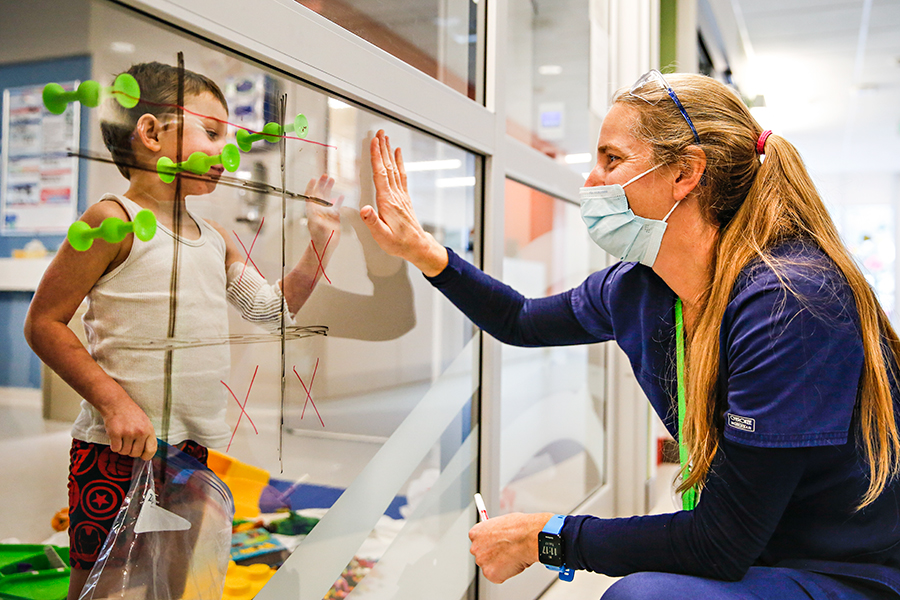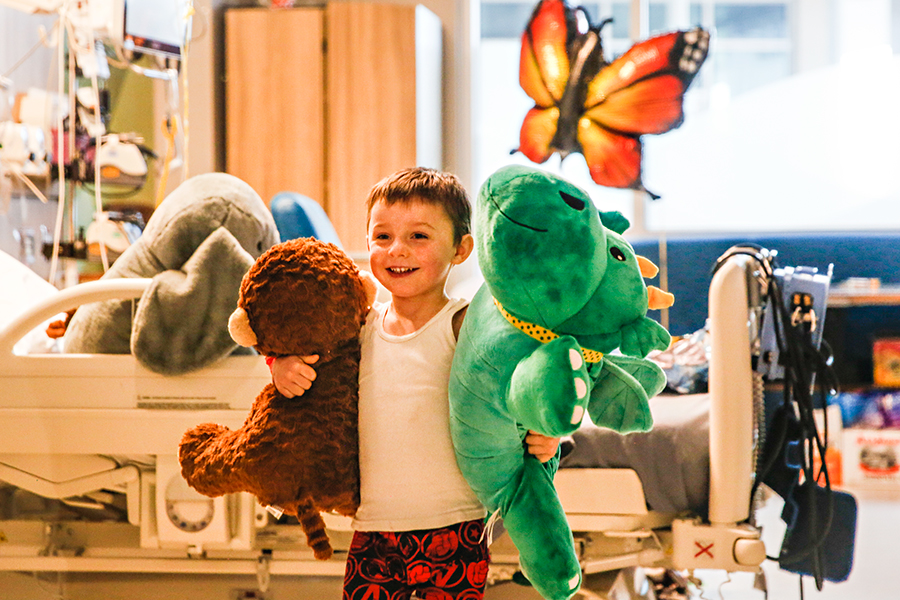Three-Year-Old Boy Hospitalized with Rare Syndrome Linked to COVID-19
Tobias Warren required "aggressive ICU-level resuscitation" during 10-day hospitalization for multisystem inflammatory syndrome in children (MIS-C)
By Myers Reece
Three-year-old Tobias Warren smiled as he contemplated his next move on a Tic-Tac-Toe grid that was hand-scrawled in marker on the glass door of his negative-pressure hospital room at Montana Children’s medical center.
On the other side of the glass, the boy’s charge nurse during his lengthy hospitalization, Emily Casey, considered her own move. Dr. Timothy Stidham, a pediatric critical care physician who had been treating Warren for a rare but severe inflammatory syndrome linked to COVID-19, rooted for Warren to “go for the corners!” Dr. Austine Siomos, a pediatric cardiologist, joined the cheering.
It was a welcome scene of exuberance after a harrowing period for Warren, who had been hooked up to oxygen for eight of the nine days since he first arrived at the hospital with cherry-red lips and swollen eyes, abdominal pain and vomiting, and unable to hold down fluids with a fever of 104.9 degrees.
Stidham said Warren, upon admission, needed multiple blood-pressure medicines and showed signs of kidney failure and liver inflammation, along with blood-clotting abnormalities, fluid leakage in the lungs and an altered mental state.
“He was in pretty significant shock,” Stidham said. “In the first 24 hours, he required really aggressive ICU-level resuscitation and minute-to-minute care.”
Warren is one of three kids in Montana, according to Stidham, to develop multisystem inflammatory syndrome in children, or MIS-C, a highly uncommon but potentially lethal condition that attacks the organs and bears hallmarks of Kawasaki’s disease, although with differences, including its specific connection to COVID-19.

As of Oct. 30, the Centers for Disease Control and Prevention (CDC) had confirmed 1,163 cases of MIS-C nationwide, including 20 deaths. The CDC says 98% of MIS-C cases involved children who had tested positive for SARS CoV-2, the virus that causes COVID-19, while the remaining 2% were around someone with COVID-19.
While deaths have been rare, Siomos, the pediatric cardiologist, noted that medical intervention is critical.
“These kids would probably die if they didn’t come to the hospital,” she said.
The syndrome can cause problems with heart muscles and coronary arteries. Children with the condition are told not to return to organized athletics for six months. Siomos said Warren was fortunate not to suffer severe coronary dilation, and had no aneurysms, but doctors will continue monitoring his heart for an extended period.
“We’ll have to watch him for a long time,” she said.
While MIS-C is rare, research has raised concerns about potentially more common impacts of COVID-19 on the heart. The Ohio State University Wexner Medical Center found signs of possible myocarditis, which can cause heart failure and sudden cardiac death, in four out of 26 college athletes who had recovered from COVID-19. Additionally, eight of the athletes studied, roughly one-third, had evidence of scar tissue that suggested prior myocardial injury.
“It’s kind of alarming,” Siomos said, adding that other research has identified higher rates of cardiac abnormalities, including a study out of Germany that found ongoing myocardial inflammation in 60 of 100 patients who had also all recovered from COVID-19.
Siomos has been researching young athletes in the area and has observed some mild cardiac abnormalities in echocardiograms and heart imaging, unrelated to MIS-C.
“Some of them are high-level athletes and they’re struggling after COVID,” she said.
But Siomos notes that most diagnoses were recent, within the last couple months, which makes it difficult to draw decisive conclusions or gauge long-term consequences. Ongoing studies tracking athletes should provide more clarity over time.
“Is it some temporary inflammation that happens or is this something we’re going to have to worry about long term for these athletes?” she said.
Children typically develop MIS-C two to four weeks after infection with the novel coronavirus, which was the case with Warren, who began showing symptoms of the syndrome about a month later. He was healthy in the weeks after his COVID-19 symptoms disappeared and before the MIS-C symptoms started.

Taylor Warren, Tobias’s mother, said she took him to the emergency room in Whitefish on Nov. 6 with a temperature of 104 degrees. He was given Tylenol and sent home. In the following days, she continued managing his temperature and watching his condition, but on Nov. 9, after he hadn’t peed in five days and wasn’t keeping liquids down, she brought him back to the ER, where he was given an IV and blood work.
Tobias was then transferred to Montana Children’s, where he began his journey of oxygen, blood-pressure and anti-inflammatory medications, heart monitoring, IVs, platelet transfusions and constant care. Siomos praised Taylor, who lives in Fortine, for her persistence and urgency in bringing in Tobias.
“How quickly you get care with this is huge,” Siomos said. “She did a great job.”
Taylor had never heard of MIS-C but understood it was serious, a reality driven home on Nov. 10, when she said her son’s breathing was particularly strained and the severity of his condition, including fluid in the lungs, became clearer.
“That second day was really scary,” she said. “I was a mess.”
Casey, the charge nurse, was in Tobias’s room for 10 of her 12 shift hours each day, providing nearly continuous care. Speaking on Nov. 17, Casey said she was heartened to watch Tobias play and run around with the aid of physical therapy.
“It’s so great to see him smiling and playing with toys and acting like a normal kid,” she said.
Although the syndrome is extremely rare, Siomos said Tobias’s case serves as a reminder, as does the growing medical literature on other COVID complications, to take the novel coronavirus seriously.
“We should have a humble approach to this virus and realize we don’t know everything, and understand we might find out even more — it could be good or it could be bad — but we need to protect each other,” she said.
Taylor said recently that Tobias, who turned 4 on Thanksgiving, “has been doing a lot better,” although he was struggling with the two daily blood thinner shots and running out of energy quickly. She was thankful for the support she and Tobias received from family when they were both confined to the hospital room for 10 days, and she was particularly grateful that the expertise of Montana Children’s specialists allowed her son to remain in his community throughout his treatment.
“The nurses and the doctors are wonderful,” she said. “They got us anything and everything we needed, and they’re really good with kids, too. It’s an amazing hospital.”